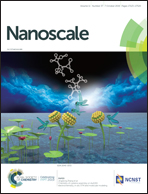Aromatic thiol-modulated Ag overgrowth on gold nanoparticles: tracking the thiol's position in the core–shell nanoparticles†
Abstract
The employment of strong covalent interactions, such as between thiol and a metal, is a unique way to regulate the morphology and/or endow plasmonic nanostructures (PNSs) with new functionalities. However, the regulation effect of thiols and the underlying mechanism in controlling the growth of PNSs are yet to be revealed. Herein, we found that aromatic thiols (ATs) with functional groups, such as hydroxyl and carboxyl groups, were able to accelerate the Ag deposition. Theoretical calculations indicated that the benzene ring can enhance the electron donating capability of these groups and thus boost their interactions with Ag+. In addition, the PNSs modulated by ATs were exposed with high-index facets. Furthermore, taking advantage of the Ag+-assisted oxidative coupling of 4-ATP molecules pinned on the surface of Au cores, the formed DMAB molecules can be used as a Raman internal reference to trace the spatial trajectory of freshly adsorbed 4-ATP molecules, which modulated the Ag deposition. Our findings highlight the flexibility and diversity of thiol-based ligands in manipulating the particle growth and tuning the particle morphology.



 Please wait while we load your content...
Please wait while we load your content...